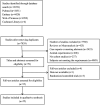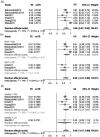Effect of bioimpedance-defined overhydration parameters on mortality and cardiovascular events in patients undergoing dialysis: a systematic review and meta-analysis
- PMID: 34496645
- PMCID: PMC8438275
- DOI: 10.1177/03000605211031063
Effect of bioimpedance-defined overhydration parameters on mortality and cardiovascular events in patients undergoing dialysis: a systematic review and meta-analysis
Abstract
Objective: To evaluate the role of bioimpedance-defined overhydration (BI-OH) parameters in predicting the risk of mortality and cardiovascular (CV) events in patients undergoing dialysis.
Methods: We searched multiple electronic databases for studies investigating BI-OH indicators in the prediction of mortality and CV events through 23 May 2020. We assessed the effect of BI-OH indexes using unadjusted hazard ratios (HRs) and 95% confidence intervals (CIs). Sensitivity analysis was used for each outcome.
Results: We included 55 studies with 104,758 patients in the meta-analysis. Extracellular water/total body water (ECW/TBW) >0.4 (HR 5.912, 95% CI: 2.016-17.342), ECW/intracellular water (ICW) for every 0.01 increase (HR 1.041, 95% CI: 1.031-1.051), and OH/ECW >15% (HR 2.722, 95% CI: 2.005-3.439) increased the risk of mortality in patients receiving dialysis. ECW/TBW >0.4 (HR 2.679, 95% CI: 1.345-5.339) and ECW/ICW per increment of 10% (HR 1.032, 95% CI: 1.017-1.047) were associated with an increased risk of CV events in patients undergoing dialysis. A 1-degree increase in phase angle was a protective factor for both mortality (HR 0.676, 95% CI: 0.474-0.879) and CV events (HR 0.736, 95% CI: 0.589-0.920).
Conclusions: BI-OH parameters might be independent predictors for mortality and CV events in patients undergoing dialysis.
Keywords: Bioimpedance-defined overhydration; cardiovascular event; dialysis; meta-analysis; mortality; outcome.
Conflict of interest statement
Figures



Similar articles
-
Clinical significance of multi-frequency bioimpedance spectroscopy in peritoneal dialysis patients: independent predictor of patient survival.Nephrol Dial Transplant. 2014 Jul;29(7):1430-7. doi: 10.1093/ndt/gfu049. Epub 2014 Mar 5. Nephrol Dial Transplant. 2014. PMID: 24598280 Clinical Trial.
-
Bioimpedance-defined overhydration predicts survival in end stage kidney failure (ESKF): systematic review and subgroup meta-analysis.Sci Rep. 2018 Mar 13;8(1):4441. doi: 10.1038/s41598-018-21226-y. Sci Rep. 2018. PMID: 29535377 Free PMC article.
-
Extracellular water/total body water ratio as predictor of mortality in hemodialysis patients.Ren Fail. 2021 Dec;43(1):821-829. doi: 10.1080/0886022X.2021.1922442. Ren Fail. 2021. PMID: 33966595 Free PMC article.
-
The predictive value of bioimpedance-derived fluid parameters for cardiovascular events in patients undergoing hemodialysis.Ren Fail. 2022 Dec;44(1):1192-1200. doi: 10.1080/0886022X.2022.2095287. Ren Fail. 2022. PMID: 35856161 Free PMC article.
-
The Effect of Overhydration on Mortality and Technique Failure Among Peritoneal Dialysis Patients: A Systematic Review and Meta-Analysis.Blood Purif. 2018;46(4):350-358. doi: 10.1159/000492148. Epub 2018 Sep 6. Blood Purif. 2018. PMID: 30189422
Cited by
-
Bioimpedanciometry in nutritional and hydration assessments in a single dialysis center.J Bras Nefrol. 2023 Jul-Sep;45(3):277-286. doi: 10.1590/2175-8239-JBN-2022-0037en. J Bras Nefrol. 2023. PMID: 36469485 Free PMC article.
-
Body fluid volume calculated using the uric acid kinetic model relates to the vascular event.J Artif Organs. 2024 Sep;27(3):253-260. doi: 10.1007/s10047-023-01421-z. Epub 2023 Dec 11. J Artif Organs. 2024. PMID: 38079049
-
Body Composition and COPD: A New Perspective.Int J Chron Obstruct Pulmon Dis. 2023 Feb 8;18:79-97. doi: 10.2147/COPD.S394907. eCollection 2023. Int J Chron Obstruct Pulmon Dis. 2023. PMID: 36788999 Free PMC article. Review.
-
Future lines of research on phase angle: Strengths and limitations.Rev Endocr Metab Disord. 2023 Jun;24(3):563-583. doi: 10.1007/s11154-023-09803-7. Epub 2023 Apr 12. Rev Endocr Metab Disord. 2023. PMID: 37043140 Free PMC article. Review.
-
Hypervolemia in Dialysis Patients Impairs STAT3 Signaling and Upregulates miR-142-3p: Effects on IL-10 and IL-6.Int J Mol Sci. 2024 Mar 27;25(7):3719. doi: 10.3390/ijms25073719. Int J Mol Sci. 2024. PMID: 38612530 Free PMC article.
References
-
- US Renal Data System 2019 Annual Data Report: Epidemiology of Kidney Disease in the United States. Am J Kidney Dis 2019: S0272-6386(19)31008-X. doi: 10.1053/j.ajkd.2019.09.002. - PubMed
Publication types
MeSH terms
LinkOut - more resources
Full Text Sources
Medical

